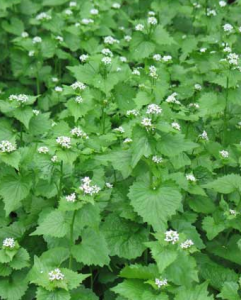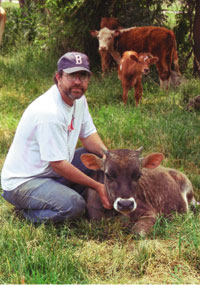Foraging puts a fresh perspective on the terms “spring greens” and “field greens” listed on swanky restaurant menus. Apparently, April and early Spring are prime time to harvest field greens.
The reason is this, in a plant’s lifecycle Spring is a time when the growing energy of the plant moves from it’s root system underground, up into the leaves to capture the Sun’s energy and convert it to sugars to grow the plant’s flowers that eventually seed and reproduce. It is best to harvest leaves while they are still new and tender and contain most of the plant’s sugars, making them more palatable and not bitter and stringy. Once the plant flowers, the plant’s sugars get concentrated into developing the flowers and the seeds. The leaves are usually still edible, but not so tasty and sometimes poisonous (part of the plant’s defense mechanism).I see this happening with the garlic mustard in my yard. The ones with flowers are not as tasty. This is also true of roots. According to Matt Pearson of Howling Wolf Biodynamic Farm in Hope, NJ, you want to harvest roots either before the greens really shoot up in Spring (while the plant still has its sugars in the roots) or after a frost in Fall (when the plant begins focusing it’s energy down into the ground in preparation for Winter). This was conveyed to me while digging up parsnip, sarsaparilla and burdock roots with him on a chilly rainy March day. But I digress.
In terms of environmental impact, most of the “spring greens” and “field greens” that you buy in a supermarket, organic or not, are usually not harvested from a field in the Spring, but grown year round, sometimes in a hydroponic greenhouse, in faraway lands. This is environmentally wrong on so many levels. Collectively, supermarket produce is better travelled than most of their consumers and the Travelocity gnome combined. This is absolutely not an environmentally friendly or sustainable way of eating. Consider all the fossil fuel it takes to ship refrigerated greens from California or Mexico to a plate in NJ in January. Consider the resources it takes to grow hydroponic greenhouse produce – water and electricity. Consider the single-use disposable packaging it comes in, the resources it takes to produce and transport the containers to package the greens and the resources it takes to dispose of it responsibly and what it takes to recycle it. Alternatively, it may just sit in a landfill for the next 700 years because said consumer bought it on the go and can’t find a convenient recycle bin.. or it often ends up in the ocean where an endangered animal will consume the debris and die. (Yes, Vegans and PETA, don’t preach to me about animal cruelty if I see you buying salad greens in a big plastic box and drinking water from a plastic bottle.)
To me it is a colossal waste relative to the volume of and availability (my backyard) of greens I am consuming and another form of enslavement to the vicious consumer waste stream.. just so I can have some caesar salad with questionable nutritious value and life force. Harvesting your own food, rather than depending on a corporate system, builds qualities of independence and environmental stewardship in one’s character. The best and most environmentally responsible thing to do is to stop spraying our lawns with “cides” – herbicides, pesticides, weed killers and fertilizers. And harvesting fresh greens right outside our own homes, every day through the growing season. It is the simplest form of gardening. Free. No weeding, no cultivating or fertilizing. Just let it be and let Nature do her thing and she will nourish you.


Posted on April 28, 2011 by Sustainable Sachi
0